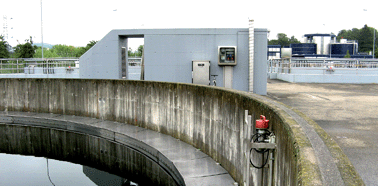We propose and evaluate a mode-of-action based test battery of low-complexity and in-vitro bioassays that can be used as a routine monitoring tool for sewage treatment efficiency and water quality assessment. The test battery comprises five bioassays covering five different modes of toxic action. The bioluminescence inhibition test with Vibrio fischeri and a growth rate inhibition test with the green algae Pseudokirchneriella subcapitata are measures of non-specific integrative effects. A second endpoint in the algae test, the specific inhibition of the efficiency of photosynthesis, gives an account of the presence of herbicides. An enzymatic assay covers an important aspect of insecticidal activity, the inhibition of the acetylcholine esterase activity. Estrogenic effects are assessed with the yeast estrogen screen (YES) and genotoxicity with the umuC test. Three field studies, each lasting six to seven consecutive days, were undertaken at a sewage treatment plant (STP) in Switzerland. Samples were collected in summer and late autumn, under dry and rainy conditions. None of the bioassays gave positive results with raw water in whole effluent toxicity testing. Therefore, water samples from various sites during wastewater treatment and from surface water were enriched with solid-phase extraction. The focus was on non-volatile compounds of average to moderate hydrophobicity, a range that includes most pesticides, biocides and pharmaceuticals. Various polar solid phases were evaluated for their extraction efficiency, disturbance by matrix components and overall performance. We finally selected a mixture of a polymeric sorbent and a C18-sorbent, Lichrolut EN and RP-18 or, alternatively, Empore™ SDB-RPS disks. All bioassays gave clear and robust responses with the SPE extracts. With the bioassay data the treatment efficiency of the STP can be assessed with respect to different modes of toxic action and accordingly different groups of micropollutants. Furthermore, the data allowed for a comparison between the effluent and the receiving river. In all bioassays the primary effluent had a strong effect and this effect was reduced after passing the STP. Treatment efficiency was high (typically over 90%) but varied from bioassay to bioassay, which is expected because each bioassay detects different types of micropollutants and therefore we cannot expect a common answer.

You have access to this article
 Please wait while we load your content...
Something went wrong. Try again?
Please wait while we load your content...
Something went wrong. Try again?


 Please wait while we load your content...
Please wait while we load your content...